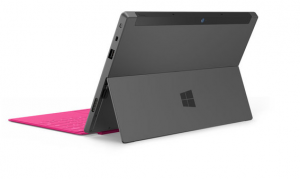Here’s the comparison between Microsoft Surface vs ASUS Transformer Prime. Their specification and features are explained below.
Microsoft has recently launched its Surface tab in the market which runs on the Microsoft Windows 8 OS. Though it has become the gossip of the town but we can never really forget the Google’s amazing Android OS and the tabs running on it.
Design
At the first glance it is really difficult to say which one looks better but the Surface’s vibrant touch and type covers definitely add an eye-candy to the device which seems missing in the Prime.
Ignoring the covers, both the tabs look like simple rectangular touch screen devices. While the Surface is 9.3 mm thick the Prime is 8.3 mm thick and weighs less than the surface.
But we cannot overlook the Surface’s kickstand which is quite handy and innovative. The Prime on the other hand features a ‘metallic spun’ back design.
Display
The Surface features a 10.6 inches full HD display with 1280×720 p resolution. The Prime on the other hand has a .5 mm less i.e. 10.1 inches display with 1280×800 p resolution which is better than the Surface.
Accessories
The surface has a touch cover for typing which seems to be meant for fun rather than productivity because the keys do not have much depth and could be annoying for some users typing at fast speeds, but it also doubles up as a magnetic cover which intelligently turns OFF the device when closed. The Prime on the other hand has a fully functional additional keyboard like the PCs. It also provides the device an additional battery of 6 hours when connected. But it weighs as much as the tab itself and will make it difficult for the user to carry the device while it is connected.
Hardware Specifications
Both the tabs have the same Tegra 3 chipset with almost the same processor legacy. Both of them have ample storage memory; the Prime has storage options of 32 GB and 64 GB whereas the Surface has options of 64 GB as well as 128 GB. In the terms of connectivity options the Prime has a Micro HDMI slot alongside with a Micro SD card reader. But when connected with the heavy keyboard dock it gives an option of a card reader and USB 2.0 as well. While in case of Surface, we have Micro SDXC, USB 3.0 and a mini display port as well. So it depends on the user what he wants; more mobility or better connectivity.
Operating System
While the Asus Prime runs on Google’s Android OS 4.0 popularly known as Ice-cream Sandwich, the Surface runs on the recent Microsoft Windows 8 RT which is yet to be released to general public. The Windows’ ‘live tile’ interface is bound to turn some heads with its interactivity. But Windows RT lack great apps for the users which is the USP of Android in the face of Google Play Store. So Microsoft needs to work on that. Also, Google is ready to launch the next generation of its operating system under the name JellyBean. This is expected to be even more grandiose than the existing ICS OS.
So on one side the user has an option for a gleaming new interface of Windows 8 but on the other hand he has an option of millions of apps on the Android OS. So it depends on the user what he chooses to opt for.
Conclusion
Both the tabs give head to head completion to each other and it is on the user to choose between the latest technology and looks of Surface or the mobility of Prime.


